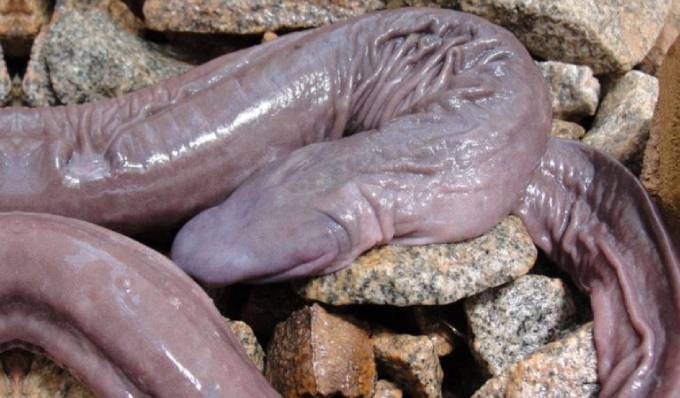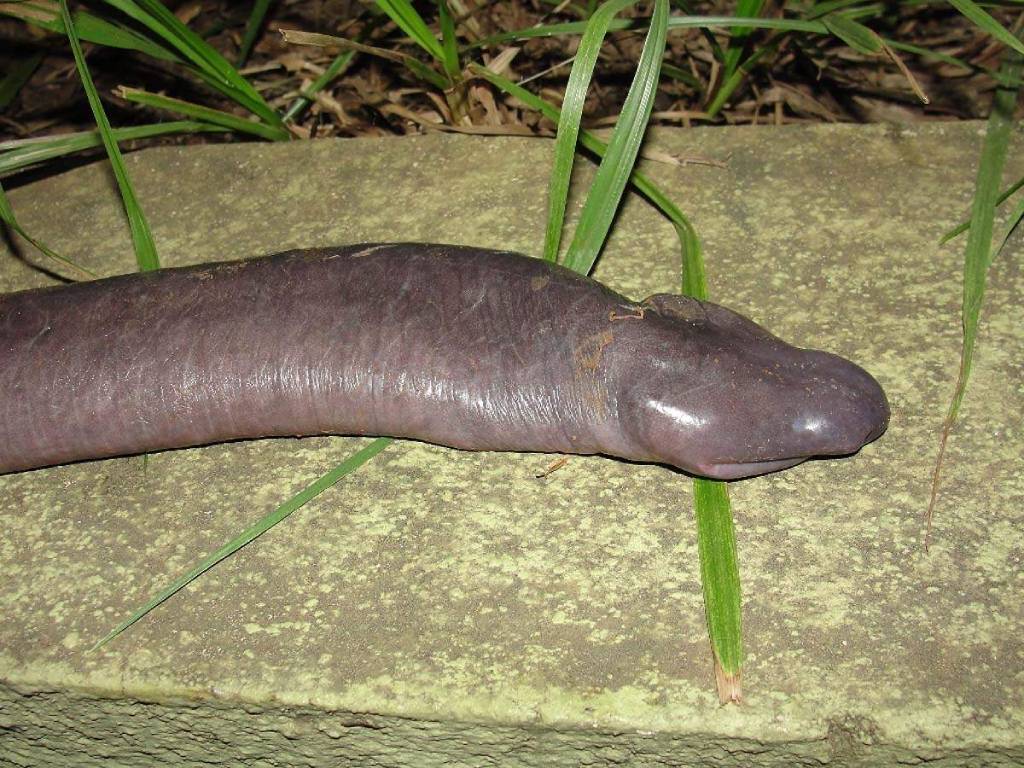The moment you set eyes on the penis snake, you’ll understand how it earned its name. In short, it looks like a penis.
But, the Atretochoana eiselti or typhlonectes natans – before reclassification, is not a snake, nor is it a penis.
Meet the penis snake
A little natural history: this creature was first spotted in the 1800s by Sir Graham Hales in the Madeira River, a tributary of the Amazon river in the Brazilian rainforest. The examples that Hales found two hundred years ago were the only preserved specimens until recently. That is, until 2011, when they were found in almost the same location alive and well!

It is a caecilian subset of the lungless tetrapods, looks a little like a snake but has rings like an earthworm.
Typhlonectes natans facts
In 1968 the penis snake was categorized in the typhlonectes natans genus. However, a further study led to its reclassification. It now has its own genus – Atretochoana. They live for 5-10 years, reaching nearly 3 feet long, and eat small animals, such as small fish, worms, and other aquatic invertebrates. Its favorite habitat is aquatic vegetation, specifically slow-moving bodies of water.
The penis snake is a strong swimmer and has a fleshy dorsal fin. It breathes oxygen and has no lungs, exchanging air through blood capillaries at the skin’s surface.
This particular species is more closely related to the frog than a snake. It has poor eyesight but a highly acute sense of smell which it appears to use while hunting.
The arrival of this non native species
Penis snakes are a non native species to the US. However, one was found in the Florida canal near Miami International airport two years ago. At the time, the wildlife commission was doing a routine survey. They tried to feed it a variety of items but it refused to eat, and the animal eventually died.
Since then, several penis snakes have been discovered in Miami’s Tamiami canal; that’s the same canal.
The original penis snake found two years ago was sent to the Florida Museum of Natural History for DNA analysis. Geneticists identified this floppy snake as a penis snake, leading to the question of how many other invasive species have joined the native reptiles usually found in South Florida?
This particular species likely arrived as another of the many discarded pets. Since the re-discovery of these creatures, they have become a popular part of the pet trade.
Is the penis snake dangerous?
The penis snake is certainly scary-looking. It’s a strange cross between a snake and a limbless amphibian.
However, that’s about as dangerous as this non-native amphibian gets. It feeds on small animals and, thanks to its very poor eyesight, relies on an enlarged mouth and excellent sensory tentacles to find and capture food. It’s doubtful it would pose any threat to humans.
If this creature is found outside of a national park, it is more at risk from humans as pesticides, fertilizers, and an array of other human pollutants could damage the fragile habitat it calls home.
Potential for ongoing study
The arrival of atretochoana eiselti in the US begs the question of how many more of them are there? At present, it is unknown if these are simply a few unwanted pets discarded in the same canal or if there is a significant presence.
Ongoing studies by the Florida Museum will focus on whether these are serious predators or simply another species to be fed on by larger animals.
It is also an opportunity to look at the penis snake in relation to other caecilians. There are many variants of this species; some burrow underground, while this specific species prefers fresh, slow-moving, warm water.
Of course, it will also be essential to discover if this species has found its way into other parts of the US. The one located in 2019 is believed to be the first in the US.
Who needs lungs anyway?
The penis snake is unusual even within its category of caecilians. This species usually have two well-developed lungs or just one well-developed right lung. The penis snake has none, and it is not exactly clear how it survives.

While the capillaries allow the transfer of gases, this is slowed in warm water where the penis snake appears to enjoy living. Scientists are currently debating whether this species has a low need for oxygen.
It is worth noting that it isn’t the only species without lungs; other amphibians, such as the salamander, don’t have lungs.
Final thoughts on the penis snake
This creature appears to be native to only one specific part of the Brazilian rainforest, making it highly likely it has been discarded or escaped in Florida.
While it looks like a penis, it deserves the attention of scientists to ascertain its impact on the local ecology and whether it can flourish in the US or not.
After all, the development of the Amazon is likely to damage its original habitat, potentially making it extinct before it is fully understood.


